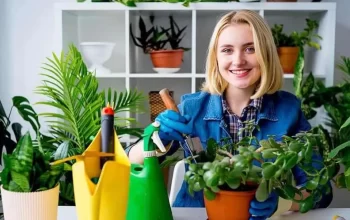Growing food is an exciting and hands-on way to lower your family’s environmental footprint. It can also save you money, sometimes in unexpected ways!
Many vegetables need full sun, so be sure your garden spot gets at least 6 to 8 hours of direct sunlight a day.
Consider mixing in flowers, such as marigolds, to discourage pests and attract pollinators.
Make a Plan
Growing your own vegetables and fruits offers benefits to both your personal and planetary health. It helps build a circular waste stream, educates you on your climate and region, and can save you money.
Josh: You can start small, with a windowsill of herbs or with a backyard vegetable plot. Things that you harvest often, like beans and carrots, you want to put close by, and things that you only harvest once a year can go further away.
Remember, your garden needs a lot of nutrients to grow healthy plants. That’s why it is important to make a plan before planting. The first step is to make a soil test. It will tell you how much fertilizer is needed to create the ideal soil.
Soil Preparation
Soil is a vital, living ecosystem that provides nutrients and water to plants. It forms through a complex combination of natural and artificial processes under specific environmental conditions.
The type of soil you grow in will determine what kinds of food you can produce. Some plants thrive in sandy, well-drained soils while others need moist, clayey soil. Many prefer something in between, called loamy soil.
Take a soil sample and test it for its physical structure. If the soil clumps together and feels slippery, it has high clay content; if it holds a loose ball but crumbles easily in your hand, it’s loamy. Also, test the soil for its pH and mineral content. Check with local Cooperative Extension Services for low cost testing or purchase a do-it-yourself kit.
Planting
Whether you have an actual garden, a small balcony or a window ledge, daily plant care can yield fresh, nutritious fruits and vegetables. Growing food requires a bit of patience as plants need time to grow and mature before they are ready for harvesting. It is also helpful to pick foods that your family eats often. You will not be successful in growing eggplants or zucchinis if no one in your household likes them!
Consider buying seeds in bulk to save money on your initial investment. Easy to grow vegetables include leafy greens (such as arugula or baby spinach), squash and beans. You can also sow flowers to attract pollinators and create a beautiful edible garden. Try keeping a journal or photo diary to track the progress of your plants throughout the season.
Watering
Growing your own fruits, veggies and herbs saves money on groceries. It also reduces food waste and supports pollinators, which helps the environment by lowering greenhouse gas levels.
Gardening requires careful planning to ensure you have enough room for the crops you want. But even if your garden is just a patch of fire escape, a sunny windowsill or a shared outdoor space, you can still grow plenty of delicious and healthy produce.
Using your map of your garden space, make sure you can find the best spots for each crop — such as placing taller veggies like beans and squash against fences or in trellises so they don’t shade shorter plants. You’ll also want to be aware of the amount of sunlight each area receives, as this changes throughout the day and year.
Harvesting
At its most basic, growing food is just a matter of sticking seeds in the ground and watering them. But there are a few nuances to the process that need to be taken into account.
For those with limited space, consider growing leafy greens like kale, lettuce and arugula or cucumbers, radishes, and tomatoes in pots on your balcony or windowsill. These crops grow quickly and produce the most food per square foot.
Edible gardens also provide a home for pollinators and reduce greenhouse gas levels. Plus, there’s nothing better than eating fresh vegetables and fruits you grew yourself! If you’re really committed to growing your own food, you might even want to start a home orchard to harvest apples and pears.





